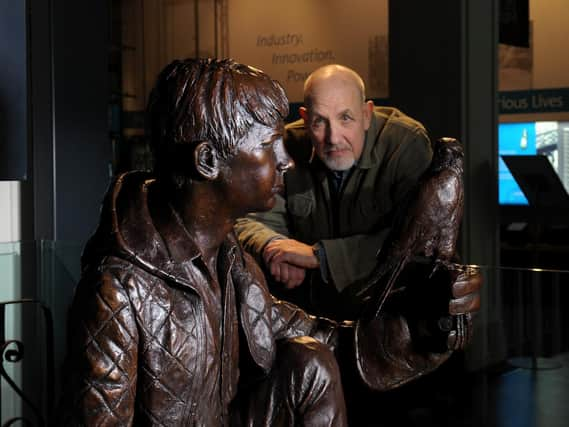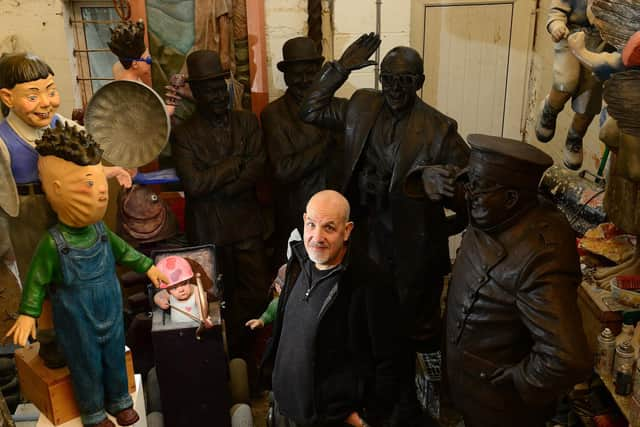From Dickie Bird to Kes, Graham Ibbeson's sculptures have a story to tell


It was awarded annually at Cudworth Secondary Modern to a pupil who had excelled themselves in the art class. Each year, a new name was engraved and among them you will find a certain Graham Ibbeson. And that gives the cup an added significance.
Today, Ibbeson is one of Yorkshire’s best-loved sculptors and artists, whose work can be found not only here, but around the world.
Advertisement
Hide AdAdvertisement
Hide AdNot that being an artist was a likely job option for a lad growing up in Barnsley in the 60s. “I remember sitting in the career master’s office with my mum. I was going to be 15 in the summer holidays so I was about to leave school. The master had already suggested that I might go down the pit – like my dad – and that didn’t really appeal at all. He then asked if farming might appeal. But as he was going through the very limited options, there was a tap at the door, and someone said to me, ‘You’d better get a move on – you’re wanted in assembly’.


“So off I went, and it turns out that it was the prize-giving and I was called up to be given the award for most progress in art. To say I was rather surprised isn’t the half of it. I didn’t even think that I’d got much talent.
“It wasn’t until later that I had a look at all the previous winners, whose names were there with mine. They were all girls, not a single fella. I have no idea what happened to that trophy – I had to give it back, and the school is no longer there.”
This, though, wasn’t the moment his artistic career started. Instead he became an electrical apprentice for the National Coal Board. It was a year or so later that he was urged to look at going to art college. “My mum had a friend called Mavis and she’d seen some of my drawings,” Graham recalls. “She thought I had talent and told me to investigate further. I naively thought that she meant evening classes but she meant Barnsley College.”
Advertisement
Hide AdAdvertisement
Hide AdHe applied and got in. And this was the start of an odyssey that has taken him to London (the Royal College of Art, no less), teaching roles in Leeds and Manchester, international exhibitions and acclaim, and back to a studio in Barnsley.
Not any old studio, however, but part of the council-run Cooper Gallery, which, conveniently, is a short walk from the home he shares with his wife Carol. They have been married 51 years and have three grown-up children and he is quick to praise her. “There were a few ups and downs when I was getting started but she’s been so supportive.”
His figurative work began to get noticed early on, having switched from studying ceramics to sculpture. His work was soon being promoted in some of London’s best galleries and at European art fairs.
Having moved to the capital, he returned to Barnsley in 1978 where he and his wife have been ever since. His home town also has two of his best statues. One is of his friend Dickie Bird, another of Barnsley’s famous sons. It depicts Dickie in familiar pose with a finger raised to give a batsman out.
Advertisement
Hide AdAdvertisement
Hide AdThere was, chuckles Graham, a little bit of controversy about the position of the finger. “I suggested something a little less provocative, but Dickie was having nothing of it, and after it was unveiled quite a few outlandish things were hung from that finger that really shouldn’t have been. We solved the problem by raising the plinth, so that it was rather more out of reach.”
The second work commemorates Hoyland-born author Barry Hines. It isn’t a sculpture of him but arguably his most famous character, Billy Casper, the schoolboy from his novel A Kestrel For a Knave. The piece shows Billy with Kes on one knee looking into the distance. “I wanted it to say a lot about freedom, about aspiration,” he says. It is currently housed in the town’s library but will eventually move outside once redevelopment work in the town centre has been finished.
Graham isn’t much impressed with the recent controversy about statues. “I can see that people would object to some of them,” he says, “but to simply eradicate them entirely seems so very wrong. They should remain, but be explained and interpreted correctly with the facts that we know today. You cannot airbrush, or rewrite, history just because perceptions have changed.”
He points to his Benny Hill sculpture in Southampton, where the comedian was born. “A lot of the programmes that he made were, you might argue today, remarkably sexist. But, and it is a very big ‘but’, in his day he was incredibly popular, watched by millions on TV. He was ‘of his time’ and today’s prevailing views can’t change those facts.”
Advertisement
Hide AdAdvertisement
Hide AdGraham doesn’t specialise in a particular subject matter and has sculpted everyone from comedians and sporting stars to pit workers and businessmen. One of his most poignant works is in the centre of Leeds, and depicts a Second World War airman, Arthur Louis Aaron.
He was badly injured during a raid in which other crew members in his Stirling bomber were also killed or injured, but managed to help get the plane back to their base in North Africa. Aaron, who was just 21, later died from his injuries and was awarded the Victoria Cross and the Distinguished Flying Medal. The sculpture shows him standing next to a tree of life, on which three children try to scramble to the top, with one holding a symbolic dove of peace, which is ready to fly.
His work, as well as drawing widespread praise, often benefits the local economy. After his glorious Eric Morecambe statue was unveiled on the Morecambe seafront, the revenue from visitor parking rose by £100,000 in the first year alone.
He is proud of many of his works, particularly the laughing trio of black footballers Cyril Regis, Laurie Cunningham and Brendan Batson installed in West Bromwich town centre.
Advertisement
Hide AdAdvertisement
Hide AdOne work that is deeply personal to him is the Oaks Memorial in Barnsley. The sculpture is dedicated to the 361 miners and rescuers killed in the Oaks Colliery disaster of 1866. It was England’s worst mining disaster and Graham’s great-uncle George Ibbeson was among the victims.
After battling ill health last year, Graham is nearly fighting fit again and concentrating on producing a wealth of drawings, mainly in charcoal. “I can’t get the energy up, yet, to lift a full bag of clay up to make models, so Carol is doing the hefting for me. But it’ll come.”
Much of his work is shot through with humour and reflects his own personality and it’s helped him along the way. “Laughter is undoubtedly the best medicine for any recovery. Where would we be without it?” He turns 70 next year but still has plenty of work left in him. “I am a very lucky man – being paid to create things that I love. Retirement? Are you kidding me?”
Support The Yorkshire Post and become a subscriber today.
Your subscription will help us to continue to bring quality news to the people of Yorkshire. In return, you'll see fewer ads on site, get free access to our app and receive exclusive members-only offers.
Advertisement
Hide AdAdvertisement
Hide AdSo, please - if you can - pay for our work. Just £5 per month is the starting point. If you think that which we are trying to achieve is worth more, you can pay us what you think we are worth. By doing so, you will be investing in something that is becoming increasingly rare. Independent journalism that cares less about right and left and more about right and wrong. Journalism you can trust.
Thank you
James Mitchinson